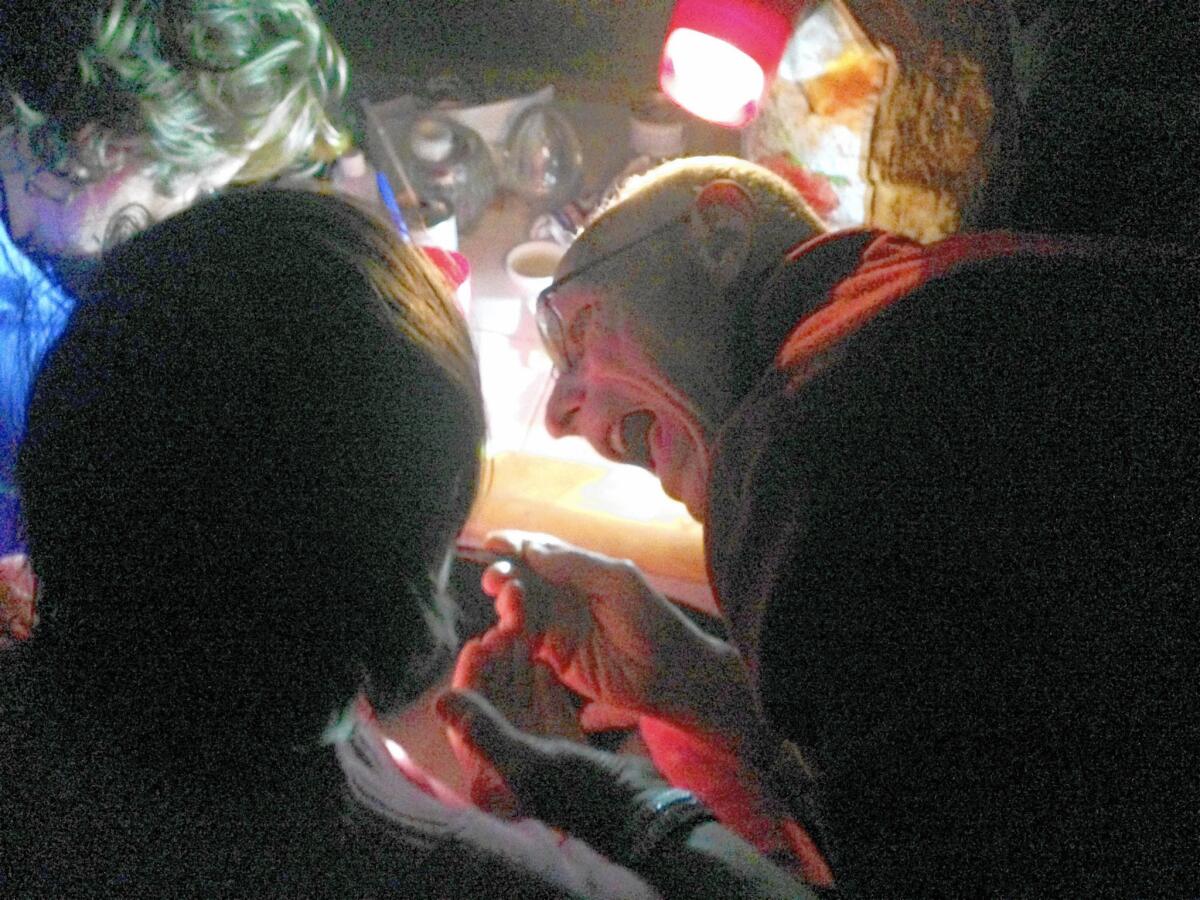Teacher juggles the different stresses of tending to a dying companion

Nick Telesca, a 72-year-old substitute teacher, got home from work at 5 p.m. and marched straight upstairs to his tiny North Hollywood apartment, ready to begin his second job. The woman he loves is dying, and he is trying to make her as comfortable as possible.
“So, Carol, we’re going to get you into the bathroom, change your diaper, sit you up and feed you so I can give you your meds,” said Telesca, who was wearing the Old Navy sweatshirt he worked in that day at a Catholic school in the San Fernando Valley.
Telesca had emailed me a few days earlier to say the financial, physical and emotional stress on him was mounting.
“My wife is dying of a brain tumor,” he wrote. “Can you help me?”
Carol Ann Gorman, 78, is not legally Telesca’s wife, though he thinks of her that way. They’ve been together 13 years, having met at a nursing home where their fathers were dying.
Telesca told me she was stronger than he was until a few months ago, when all of a sudden Gorman had trouble walking. One morning, at breakfast, she couldn’t get the spoon to her mouth and Telesca dialed 911.
The diagnosis was grim, and Gorman chose not to endure surgery or other treatment. She wanted to let nature take its course, so she was taken straight from the hospital to a nursing home.
“I don’t want to cast aspersions about the nursing home,” said Telesca, but he and Gorman’s daughter, who lives in Nevada, didn’t want her to spend her last days in a setting like that. So just in time for Thanksgiving, they brought her home.
Gorman is in hospice care, which is covered by Medicare, but that doesn’t mean around-the-clock help. A loved one, Telesca in this case, is often the primary caregiver. Gorman, who worked as a mailroom clerk at Columbia Pictures and also sold Avon products, qualifies for in-home support through MediCal.
But Telesca, like so many other older Americans, has struggled to figure out the system while dealing with his wife’s rapid deterioration. He said he and Gorman were living on Social Security and his occasional teaching wages, and chipping into their savings as well.
Last Monday, when Telesca got home from work, Gorman was in a hospital bed set up in the living room. She’d been there all day because the aide couldn’t lift her up.
“Can you please call your husband?” Telesca asked the aide, handing her $100 for a day’s work. The aide’s husband, Josue Saravia, a financial services consultant, was waiting outside to drive her home. He came upstairs to help Telesca.
“So, Carol, this is what we’re going to do,” Telesca said, talking out the strategy for getting her off the bed and into her wheelchair. “First the feet.”
Gorman, her eyes shut tight, groaned and resisted. When Telesca and Saravia got her to her feet, Gorman’s legs folded and she slumped with a gasp. Under great strain, Telesca and Saravia managed to keep her from falling and twist her onto the wheelchair. Telesca, who sometimes manages all of this on his own, then wheeled her into the bathroom to change and clean her against Gorman’s protests.
“Awwwwww, I can’t stand it!” she shrieked.
As if he needed one more challenge, the toilet clogged. Telesca worked a plunger with one hand while steadying Gorman with the other.
“I’ll deal with that later,” he finally said, leaving the plunger and a pile of soiled clothes on the bathroom floor and wheeling Gorman out to the kitchen for dinner.
Saravia was ready to leave, but not before Telesca pleaded with him to bring his wife back at 7 the next morning so he could go to school again. He wasn’t making enough money teaching to cover what he was paying for in-home care, but he didn’t want to jeopardize future opportunities by being a no-show.
“Please, I’m begging you,” Telesca said. “It’ll be a little easier tomorrow because I’ll be back at 3:30 or 4. I promise.”
Saravia gave his word. When he was gone, Telesca turned to the business of preparing dinner for Gorman. He had pushed her wheelchair up to the table, but she was fussing and trying to push herself away. Sometimes she’s barely conscious and other times she’s hostile, but Telesca said he knows it’s not her, it’s the disease.
“She’s had trouble swallowing,” he said, pulling a blender out of the cupboard to puree her food.
He didn’t get far, though, before the power in the building went out, killing the lights.
“Oh my God, and she’s in the wheelchair,” Telesca said, wondering how he’d be able to feed her and put her to bed in the dark. He decided on a can of Ensure rather than try to fix a meal in the dark.
Just then, a neighbor came to the rescue with a flashlight, followed by another neighbor from just down the hall.
By flashlight, Telesca fed Gorman the Ensure and then tried to spoon her medicine into her mouth with some applesauce. She resisted and kept cheeking the pills into the corner of her mouth.
“This is why I find the pills all over the floor,”Telesca said.
“OK, put the light in her mouth,” Telesca told his neighbor as she aimed the flashlight and he peered in and found a pill sitting at the back of Gorman’s tongue. “Carol, this is your life. Take a big swallow, now, come on. Open your mouth, Sweetie. It’s going to make you better.”
The food and medicine seemed to calm Gorman, and when the lights came back on, Telesca called yet another neighbor who came quickly to help transfer Gorman from wheelchair to bed. On the second floor of this modest apartment building in the flats of the Valley, there existed a neighborhood, one in which people looked after one another.
Telesca thanked his neighbor and pulled a knit blanket over Gorman. Behind her on the wall was a photo of Tony Bennett, her favorite singer. A smile crossed Gorman’s face when she heard Bennett singing on a smartphone.
After my visit, I called county social services to check on Telesca’s application for in-home care. By Thursday, an official told me the case was being expedited and Telesca or an authorized caregiver could get $9.65 an hour for taking care of Gorman. But there was still more red tape to deal with.
Telesca said he wished he and Gorman had gotten advance healthcare directives to state their specific wishes about end-of-life care. Saravia told me he advises clients to get long-term supplemental health insurance, if they can afford it. For anyone who wants to learn more about end-of-life options, I always recommend the Coalition for Compassionate Care of California.
But no matter how much planning anyone does, death, like life, can be messy. Telesca still wonders if he should have tried to persuade Gorman to have surgery, even though he was told she could die or be left in a vegetative state.
“How do you decide that?” he asked. And how, he also wondered, can he know whether it might have been better to have left Gorman in the nursing home?
Telesca looked exhausted as he sat near Gorman’s bed, finally catching a breather at the end of a long day. His world was falling apart, his partner fading before his eyes. But he would find the strength to do it all again with patience and poise, treating her with dignity, and letting her know she was not alone.
More to Read
Start your day right
Sign up for Essential California for news, features and recommendations from the L.A. Times and beyond in your inbox six days a week.
You may occasionally receive promotional content from the Los Angeles Times.







